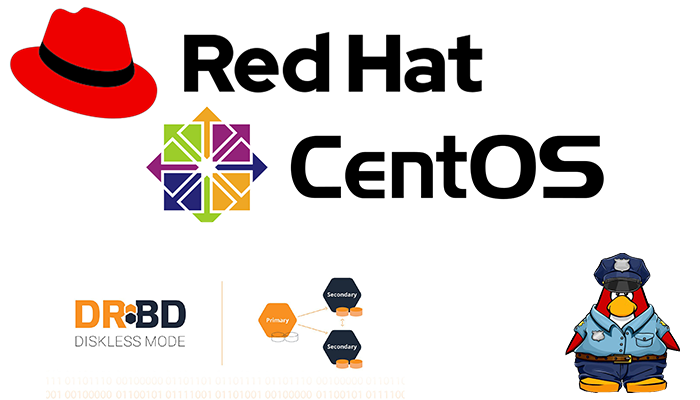Introduction
Drbd is a distributed replicated storage system for the Linux platform. It is implemented as a kernel driver, several userspace management applications, and some shell scripts. It is traditionally used in high availability (HA) computer clusters. Still, beginning with DRBD version 9, can also use it to create larger software-defined storage pools focusing on cloud integration.
If you are using the virtual kernel as part of a virtual machine, you will need to compile the drbd module manually. It may be easier to install the Linux-server package inside the virtual machine. Check drbd user’s guide and MySQL.
Create a playbook to install all requirements
Playbook provided is just a sample task to give a sequence for setting the cluster.
# cat > drbd.setupcentos8.yml
---
- hosts: all
gather_facts: no
become: true
tasks:
- hostname:
name: "{{ ansible_hostname }}"
- get_url:
url: https://www.elrepo.org/elrepo-release-8.el8.elrepo.noarch.rpm
dest: /tmp/elrepo-release-8.el8.elrepo.noarch.rpm
- name: install repo
command: rpm -ivh /tmp/elrepo-release-8.el8.elrepo.noarch.rpm
ignore_errors: yes
- command: rpm --import /etc/pki/rpm-gpg/RPM-GPG-KEY-elrepo.org
ignore_errors: yes
- shell: echo drbd > /etc/modules-load.d/drbd.conf
- yum:
name: "{{ item }}"
state: present
loop:
- drbd90-utils
- kmod-drbd90
- lvm2
- policycoreutils-python-utils
- systemd:
name: firewalld
state: stopped
enabled: no
- selinux_permissive:
name: drbd_t
no_reload: false
permissive: true
- lvg:
vg: drbdvg
pvs: /dev/sdb
- lvol:
vg: drbdvg
lv: drbdlv
size: +100%FREE
Remove the global default config from the installation.
Move the file and create a new configuration file.
# mv /etc/drbd.d/global_common.conf /etc/drbd.d/global_common.conf.backCreate the new configuration you require
The configuration file on this tutorial.
# cat > /etc/drbd.d/global_common.conf
global {
usage-count no;
}
common {
net {
protocol C;
}
}
Create a resource configuration file
Note that the resource should be the name of the file as a standard practice. In this tutorial, we will use drbd0.
#cat > /etc/drbd.d/drbd0.res
resource drbd0 {
protocol C;
net {
verify-alg sha256;
}
on node1 {
device /dev/drbd0;
disk /dev/drbdv/lvdrdb;
node-id 0;
address 192.168.55.61:7788;
meta-disk internal;
}
on node2 {
device /dev/drbd0;
disk /dev/drbdv/lvdrdb;
node-id 1;
address 192.168.55.62:7788;
meta-disk internal;
}
on node3 {
device /dev/drbd0;
node-id 2;
disk /dev/drbdv/lvdrdb;
address 192.168.55.63:7788;
meta-disk internal;
}
connection-mesh {
hosts node1 node2 node3;
}
}Resource simple requirement parameter for clustered setup
Please check the required parameters for your choice of setup
- on host-name [uname -n]
- node-id [unique node identifier. range 0 to 16]
- disk {[disk] | none}
- address [address-family] address:port
Create drbd block device
This command will create the block device required.

Enable drbd device on all nodes
Enable the device by executing the command stated below.

Check drbd status
This will output the status of the device on all nodes.

Configure who’s going to be the primary node.
This will configure where the sync should be copied from.

Check status of the cluster
Now devices are sync.

Create a filesystem from the drbd device on the primary
This will be the one being used for clustering. Note only anyone from the cluster can be chosen.

Now mount mysql directory to drbd device
Data will be shared across all nodes.

Move resource from node1 to node2
Note that MySQL service should be stopped first before the migration of resources.





